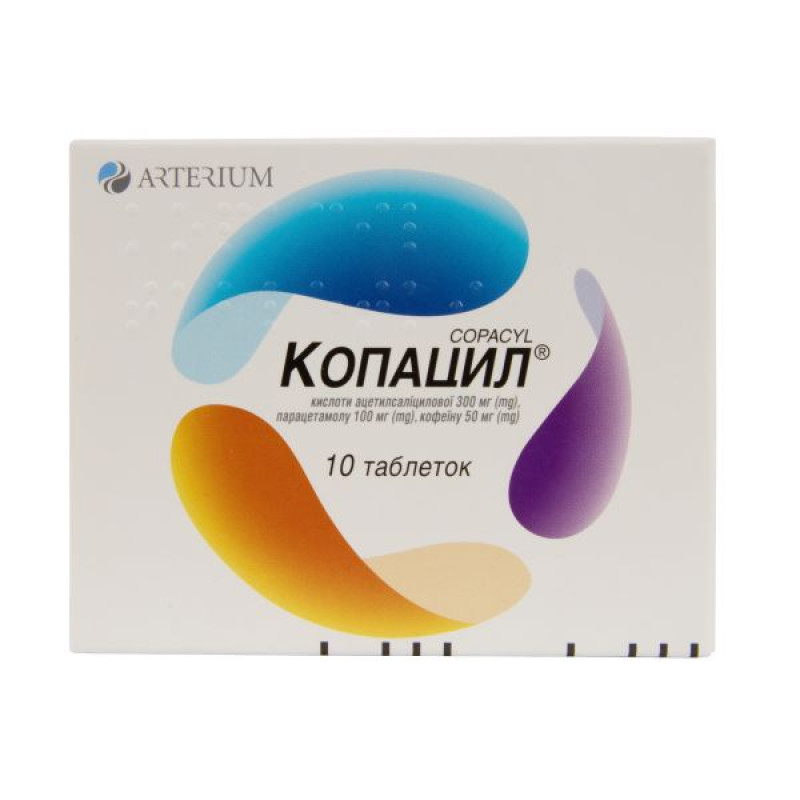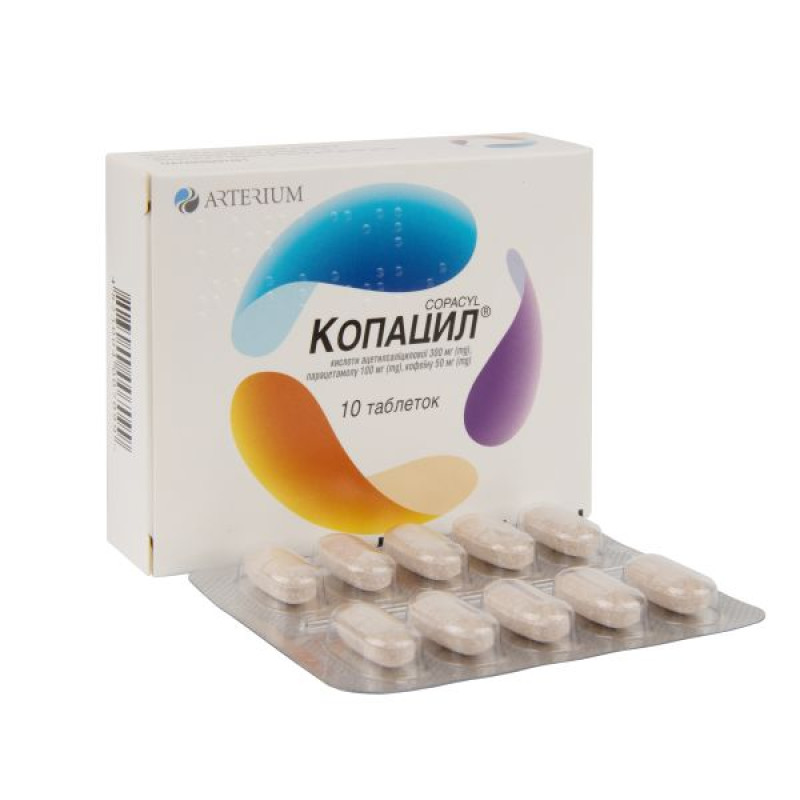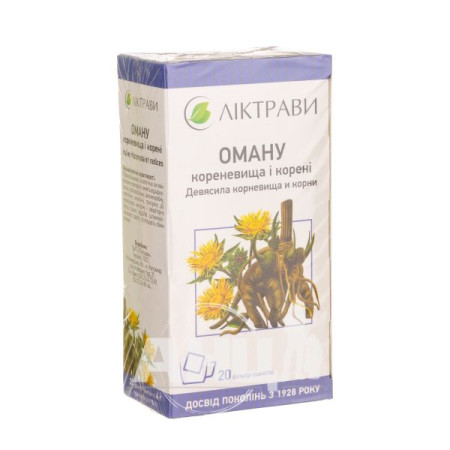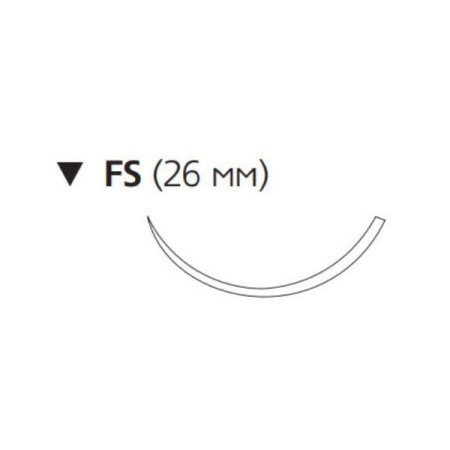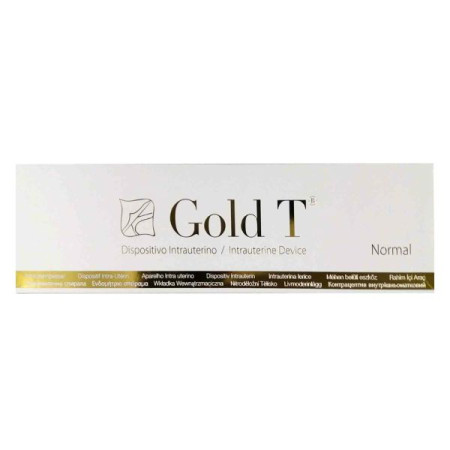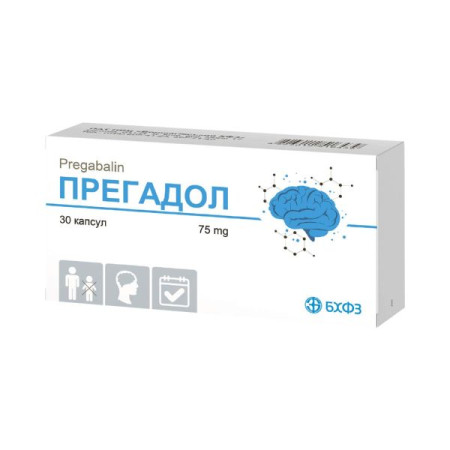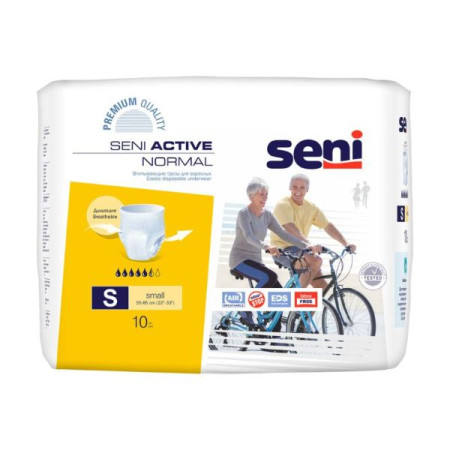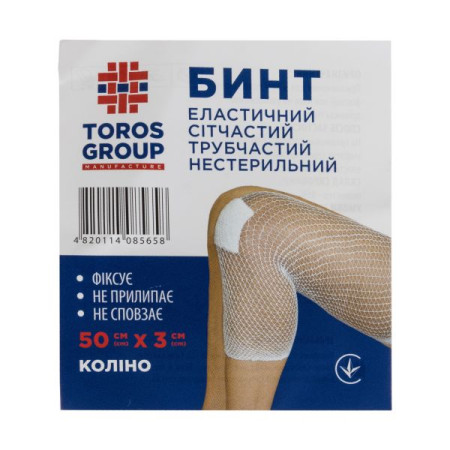Copacyl tablets blister pack No. 10
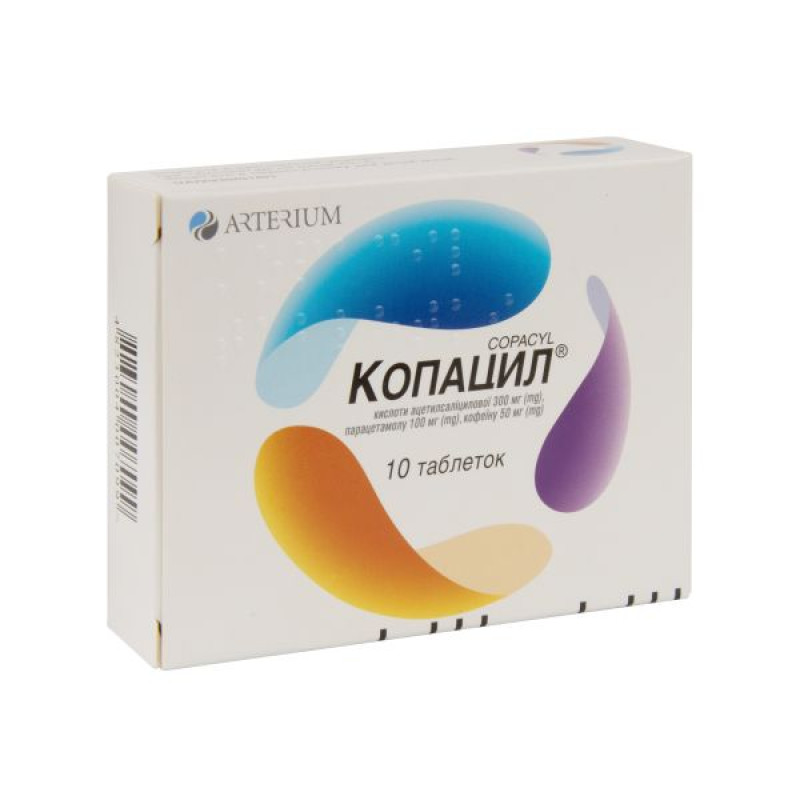
Instructions for use Copacyl tablets blister pack No. 10
Composition
active ingredients: acetylsalicylic acid, paracetamol, caffeine;
1 tablet contains acetylsalicylic acid* - 300 mg; paracetamol* - 100 mg; caffeine* - 50 mg;
Excipients: potato starch, croscarmellose sodium, hypromellose, colloidal anhydrous silicon dioxide, talc, calcium stearate, cocoa (powder), vanilla flavoring, anhydrous citric acid.
* calculated on 100% substance.
Dosage form
Pills.
Main physicochemical properties: light brown tablets with specks, oval in shape, with a biconvex surface, with a score on one side of the tablet, with the smell of cocoa and vanilla.
Pharmacotherapeutic group
Analgesics and antipyretics. ATX code N02B A51.
Pharmacological properties
Pharmacodynamics
Copacyl is a combined drug that has analgesic and anti-inflammatory effects by inhibiting prostaglandin synthesis. The components of the drug potentiate each other's effects. Acetylsalicylic acid moderately inhibits platelet aggregation, improves microcirculation in the focus of inflammation. Caffeine stimulates the central nervous system (CNS), activates the respiratory and vasomotor centers, and enhances the effect of analgesics and antipyretics.
Pharmacokinetics
The therapeutic effect of the drug occurs 30-60 minutes after oral administration, reaches a maximum after 2-2.5 hours and lasts 3-4 hours.
Indication
Mild or moderately severe pain syndrome (headache, arthralgia, migraine, toothache, neuralgia, primary dysmenorrhea). The drug can also be used as an antipyretic in diseases accompanied by fever.
Contraindication
Hypersensitivity to the components of the drug, other xanthine derivatives (theophylline, theobromine), other salicylates; bronchial asthma caused by the use of salicylates or other nonsteroidal anti-inflammatory drugs (NSAIDs) in history; congenital hyperbilirubinemia, congenital deficiency of glucose-6-phosphate dehydrogenase, blood diseases, leukopenia, anemia, thrombosis, thrombophlebitis, acute gastrointestinal ulcers, hemorrhagic diathesis, severe renal failure, severe hepatic failure, severe cardiovascular diseases, including rhythm disturbances, severe atherosclerosis, severe ischemic heart disease, severe heart failure, severe arterial hypertension, tendency to vasospasm; acute pancreatitis, prostatic hypertrophy, severe forms of diabetes mellitus; states of increased excitement, sleep disorders, epilepsy, hyperthyroidism, glaucoma, alcoholism. The period of use of MAO inhibitors, as well as for 2 weeks after their discontinuation, is contraindicated in patients taking tricyclic antidepressants or beta-blockers. Combination with methotrexate at a dosage of 15 mg/week or more.
Interaction with other medicinal products and other types of interactions
Contraindicated combinations.
Methotrexate - when combined with salicylates at a dose of 15 mg per week or more, the hematological toxicity of methotrexate increases due to a decrease in the renal clearance of methotrexate by anti-inflammatory agents and its displacement from plasma protein binding, therefore this combination is contraindicated.
Barbiturates reduce the antipyretic effect of paracetamol.
Due to the content of acetylsalicylic acid, the drug may enhance the hypoglycemic effect of oral antidiabetic drugs.
Combinations that should be used with caution.
Paracetamol: antidepressants and other microsomal oxidation stimulants - these drugs increase the production of hydroxylated active metabolites that affect liver function, causing the possibility of severe intoxication with small overdoses of the drug. The rate of absorption of paracetamol may increase with simultaneous use with metoclopramide and domperidone and decrease with use with cholestyramine. Paracetamol reduces the effectiveness of diuretics. Coumarin derivatives (warfarin) with long-term use of paracetamol increase the risk of bleeding. Under the influence of paracetamol, the half-life of chloramphenicol increases 5 times. Simultaneous use of high doses of paracetamol with isoniazid increases the risk of hepatotoxic syndrome.
Acetylsalicylic acid: simultaneous use with uricosuric agents such as benzobromarone, probenecid reduces the effect of uric acid excretion (due to competition for uric acid excretion by the renal tubules). When used simultaneously with digoxin, the concentration of the latter in the blood plasma increases due to a decrease in renal excretion. ACE inhibitors in combination with high doses of acetylsalicylic acid cause a decrease in glomerular filtration due to inhibition of vasodilator prostaglandins and a decrease in the hypotensive effect. Selective serotonin reuptake inhibitors: the risk of bleeding from the upper digestive tract increases due to the possibility of a synergistic effect. When used simultaneously with valproic acid, acetylsalicylic acid displaces it from its connection with plasma proteins, increasing toxicity.
Application features
Do not use the drug with other drugs containing paracetamol, acetylsalicylic acid. Do not exceed the indicated doses of the drug.
Existing liver disease increases the risk of liver damage from paracetamol.
In patients with bronchial asthma, allergic diseases, hypersensitivity to NSAIDs, the development of an allergic reaction or exacerbation of the underlying disease is possible. The drug is prescribed with caution to the elderly.
During treatment with the drug, it is not recommended to consume excessive amounts of beverages containing caffeine (e.g. coffee, tea). This may cause sleep problems, tremors, and an unpleasant feeling in the chest due to palpitations.
Do not drink alcoholic beverages during treatment.
Use with caution in the following situations:
hypersensitivity to analgesics, anti-inflammatory, antirheumatic drugs, as well as in the presence of allergies to other substances; gastrointestinal ulcers, including chronic and recurrent ulcers or gastrointestinal bleeding in history; concomitant use of anticoagulants; in patients with impaired renal function or patients with cardiovascular circulatory disorders (e.g. renal vascular pathology, congestive heart failure, hypovolemia, extensive surgery, sepsis or severe bleeding), since acetylsalicylic acid may also increase the risk of impaired renal function and acute renal failure; in patients with severe glucose-6-phosphate dehydrogenase deficiency, acetylsalicylic acid may cause hemolysis or hemolytic anemia. Especially in the presence of factors that may increase the risk of hemolysis, such as high doses of the drug, fever or acute infectious process; impaired liver function.
Acetylsalicylic acid may cause bronchospasm or an attack of bronchial asthma or other hypersensitivity reactions. Risk factors include a history of asthma, hay fever, nasal polyps or chronic respiratory disease, and a history of allergic reactions (e.g. skin reactions, itching, urticaria) to other substances.
Due to the inhibitory effect of acetylsalicylic acid on platelet aggregation, which persists for several days after administration, the use of drugs containing acetylsalicylic acid may increase the likelihood/increase bleeding during surgical operations (including minor surgical interventions, such as tooth extraction).
When using low doses of acetylsalicylic acid, the excretion of uric acid may be reduced. This may lead to an attack of gout in patients prone to it.
Do not use acetylsalicylic acid-containing products in children and adolescents with acute respiratory viral infections (ARI), with or without fever, without consulting a doctor. Some viral diseases, especially influenza A, influenza B and chickenpox, carry a risk of developing Reye's syndrome, which is a very rare but life-threatening illness requiring immediate medical attention. The risk may be increased if acetylsalicylic acid is used as a concomitant medication, but a causal relationship has not been proven in this case. If these conditions are accompanied by persistent vomiting, this may be a manifestation of Reye's syndrome.
If symptoms persist, you should consult a doctor.
If the headache becomes persistent, you should see a doctor.
Ability to influence reaction speed when driving vehicles or other mechanisms
In case of dizziness, potentially hazardous activities should be avoided, such as driving a car and/or performing work that requires increased attention and speed of psychomotor reactions.
Use during pregnancy or breastfeeding
Do not apply.
Method of administration and doses
Copacyl should be taken orally after meals. Adults take 1 tablet 2-3 times a day with an interval of at least 4 hours between doses. The maximum daily dose is 6 tablets (in 3 doses).
The duration of the course of treatment depends on the course and severity of the disease and should not exceed 5 days when using the drug as an analgesic and 3 days as an antipyretic.
The drug should not be used in children due to the risk of developing Reye's syndrome (hyperpyrexia, metabolic acidosis, nervous system and mental disorders, vomiting, liver dysfunction) in case of hyperthermia against the background of viral diseases.
Overdose
Symptoms of paracetamol overdose.
Liver damage is possible in adults who have taken 10 g or more of paracetamol, and in children who have taken the drug in a dose of more than 150 mg/kg of body weight. Liver damage may become apparent 12-48 hours after taking excessive doses of the drug. The following symptoms may occur in the first 24 hours: pallor, nausea, vomiting, anorexia, abdominal pain, hepatonecrosis, increased activity of "liver" transaminases, increased prothrombin index. In severe poisoning, liver failure can lead to encephalopathy, coma and death. Acute renal failure with acute tubular necrosis can manifest as severe lumbar pain, hematuria, proteinuria and develop even in the absence of severe kidney damage. Pancreatitis has also been noted. Glucose metabolism disorders and metabolic acidosis may occur. Cardiac arrhythmias have also been noted. With long-term use of high doses, aplastic anemia, thrombocytopenia, pancytopenia, agranulocytosis, neutropenia, and leukopenia may occur.
In patients with risk factors (long-term treatment with carbamazepine, phenobarbital, phenytoin, primidone, rifampicin, St. John's wort or other drugs that induce liver enzymes; alcohol abuse; glutathione deficiency, e.g. digestive disorders, cystic fibrosis, HIV infection, malnutrition, cachexia), taking 5 g or more of paracetamol can lead to liver damage.
When taking large doses, from the side of the CNS - dizziness, psychomotor agitation and disorientation; from the side of the urinary system - nephrotoxicity (renal colic, interstitial nephritis, papillary necrosis).
N-acetylcysteine treatment can be used within 24 hours of paracetamol ingestion, but the maximum protective effect is obtained when it is used within 8 hours of overdose. The effectiveness of the antidote decreases sharply after this time.
Symptoms of acetylsalicylic acid overdose.
Salicylate overdose is possible due to chronic intoxication resulting from long-term therapy (administration of more than 100 mg/kg/day for more than 2 days may cause toxic effects), as well as acute intoxication, which is life-threatening (overdose) and may be caused by accidental use by children or an unforeseen overdose.
Chronic salicylate poisoning may be latent because its symptoms are nonspecific. Moderate chronic salicylate intoxication, or salicylism, usually occurs only after repeated ingestion of large doses. The main symptoms are: balance disorders, dizziness, tinnitus, deafness, increased sweating, nausea and vomiting, headache, confusion. These symptoms can be controlled by reducing the dose. Tinnitus may occur when plasma salicylate concentrations exceed 150-300 μg/ml. More serious adverse reactions occur when plasma salicylate concentrations exceed 300 μg/ml. Acute intoxication is indicated by a pronounced change in acid-base balance, which may vary depending on the age of the patient and the severity of the intoxication. The severity of the condition cannot be determined solely on the basis of plasma salicylate concentrations.
Due to the complex pathophysiological effects of salicylate poisoning, signs and symptoms/test results may include:
Mild or moderate intoxication may be accompanied by: tachypnea, hyperventilation, respiratory alkalosis (alkalemia, alkaluria); increased sweating; nausea, vomiting.
Moderate or severe intoxication may be accompanied by: respiratory alkalosis with compensatory metabolic acidosis (acidemia, aciduria); hyperpyrexia; respiratory disorders: hyperventilation, noncardiogenic pulmonary edema, respiratory failure, asphyxia; cardiovascular disorders: arrhythmia, hypotension, cardiovascular failure; fluid and electrolyte losses: dehydration, oliguria, renal failure; impaired glucose metabolism, ketoacidosis; tinnitus, deafness; gastrointestinal bleeding; hematological disorders: platelet inhibition, coagulopathy; neurological disorders: toxic encephalopathy and CNS depression with manifestations such as lethargy, confusion, coma and convulsions.
Symptoms of caffeine overdose.
Large doses of caffeine can cause epigastric pain, vomiting, diuresis, rapid breathing, extrasystole, tachycardia or cardiac arrhythmia, and effects on the central nervous system (dizziness, insomnia, nervous excitement, irritability, affective state, anxiety, tremor, convulsions).
Treatment is determined by the severity, clinical symptoms and is provided by standard methods. In case of overdose, urgent medical attention is required, even if symptoms of overdose are absent. The appointment of methionine orally or acetylcysteine intravenously may have a positive effect within 48 hours after overdose. It is also necessary to take general supportive measures, symptomatic therapy, including the use of beta-adrenoreceptor antagonists, which can eliminate cardiotoxic effects.
Adverse reactions
Allergic reactions: skin rashes (usually erythematous, urticaria), itching, angioedema, erythema multiforme exudative (including Stevens-Johnson syndrome), toxic epidermal necrolysis, non-cardiogenic pulmonary edema, asthma.
On the part of the digestive tract: dyspeptic disorders, including nausea, vomiting, epigastric discomfort and pain, heartburn, abdominal pain; inflammation of the digestive tract, erosive-ulcerative lesions of the digestive tract, which may in rare cases cause gastrointestinal hemorrhages and perforations with corresponding laboratory and clinical manifestations.
On the part of the hepatobiliary system: increased activity of liver enzymes, usually without the development of jaundice, hepatonecrosis (dose-dependent effect).
On the part of the endocrine system: hypoglycemia, up to hypoglycemic coma.
From the side of the hematopoietic system: sulfhemoglobinemia and methemoglobinemia (cyanosis, shortness of breath, pain in the heart area), hemolytic anemia, thrombocytopenia, agranulocytosis, perioperative hemorrhages, hematomas, hemorrhages of the genitourinary system, nasal hemorrhages, hemorrhages from the gums, cerebral hemorrhages.
Hemorrhages can lead to acute and chronic posthemorrhagic anemia/iron deficiency anemia (due to so-called occult microbleeding) with corresponding laboratory manifestations and clinical symptoms, such as asthenia, pallor of the skin, hypoperfusion.
On the part of the immune system: angioedema, anaphylactic shock, which may be accompanied by cardiorespiratory failure, hypersensitivity reactions, rhinitis, nasal congestion, bronchospasm.
From the cardiovascular system: short-term arterial hypertension, tachycardia, arrhythmia.
From the side of the central nervous system: dizziness, insomnia, anxiety, tinnitus.
Urinary system: renal dysfunction and acute renal failure have been reported.
Taking the drug at recommended doses with products containing caffeine may increase caffeine-related side effects, such as increased excitability, anxiety, irritability, headache, gastrointestinal disturbances, and rapid heartbeat.
Expiration date
3 years.
Storage conditions
Store in the original packaging at a temperature not exceeding 25 °C.
Keep out of reach of children.
Packaging
10 tablets in a blister, 1 blister in a pack.
Vacation category
Without a prescription.
Producer
PJSC "Kyivmedpreparat".
Location of the manufacturer and its business address
Ukraine, 01032, Kyiv, Saksaganskoho St., 139.
There are no reviews for this product.
There are no reviews for this product, be the first to leave your review.
No questions about this product, be the first and ask your question.







